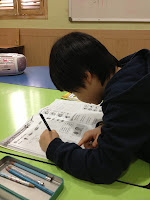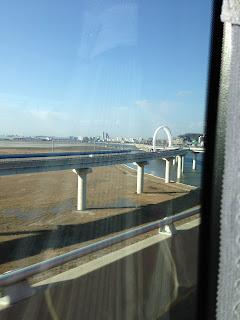An nyong ha se yo! Hello! Greetings from the Land of the Morning Calm. I've been in Korea for four weeks now and there is much to tell. Because I've waited so long to start blogging, I'm going to rely on my photos to tell most of the stories.
 |
Yes, this is me saying "Adios" in Denver, not waving hello in Korea, but I missed a photo op :(
But I made a friend on the plane, my neighbor I was sitting next to, and we exchanged info. She lives in Incheon and I'm looking forward to hanging out one of these weekends. |
I live in Anyang, a city in the province of Gyeonggi, and it isn't too far from Seoul. After arriving on Thursday in mid-April, I took a shuttle from Incheon International Airport to the Beomgye bus station, a 45 minute ride. Here are some random pictures of the scenery outside the bus window.
 |
| I was trying to take a picture of the bridge. Can you see it? |
My director, Nicky, picked me up from the bus station and took me to school where I met my fellow English and Korean teachers. I also met Hayden-teacher (from New Zealand), the English teacher I was replacing. She took me to my apartment-studio. I had packed two huge suitcases, an enormous carry-on backpack and a large purse, so I was thankful that the apartment was on the first level of the building. The entrance is in the alley of the main road.
(FYI, the literal translation of "An nyong ha se yo" means "Are you peaceful?", according to my Lonely Planet phrasebook.)
The next day, I shadowed Hayden and his classes, as they were to become my classes. I teach 2 kindy (kindergarten) classes in the morning, Dragon (2 students) and Eagle (2 students), starting at 10:30am. I am referred to as "Mary-teacher"; the other teachers also tack on "-teacher" after their names. (It sounds like "teacha" when the students say it.) I also eat lunch with the kindys at noon. I think it's pretty awesome that I get to try authentic Korean food at lunch everyday! But I wish I liked kimchi (it's served at nearly every meal!), so I hope by eating it every day I will learn to like it. I have free time after lunch until elementary classes start at 3:20pm. But it's not quite free, I have to spend the time preparing my lesson plans for each class.
Because it was Hayden's last day, one of his classes decided to bring in snacks to celebrate. It was rather fun:
 |
| The snacks were opened and thrown into a pile- salty along with sweet. I've noticed that a lot of food here is not too salty or too sweet, that even snacks we'd consider salty (potato chips) will have a sweetness to them. Even pastries won't be super-sweet. (And I'm not including ice cream.) There is a hot dog pastry at many cafes that are on a sweet pastry bun. It's so bizarre to me but I'm enjoying doing the research to try everything. |
 |
| Here is Hayden with his class: Sally, Kayla, Sam, Billy and McQueen. (Yep, McQueen!) |
Korean students who study at hagwons (where I teach) or other English academies will choose English names. They use these names at their English schools only. Sometimes their parents choose their names, sometimes it's the students themselves and sometimes it's even their English teacher. Sally and Julia are very popular names at my school.
After school was over, at around 9pm, the director took the teachers out to dinner to bid Hayden farewell. We went to a Korean BBQ restaurant. You slip off your shoes at the entrance, sit cross-legged on the parquet and await a delicious meal! The main draw is the grilled meat but you can't enjoy it without all the sides: Korean meals are known for their side dishes. Here are some photos of that meal. I don't know what everything is called and it looks like I missed taking pictures of all those sides but here you go:
 |
| The meat comes out raw and in large pieces. You place it on the grill and as it becomes to cook, someone will take scissors and cut it into small pieces. That was strange at first but it's quite handy to cut meat with scissors! The silver tube draws up the smoke from the grill. |
 |
| As you can see, chopsticks are required for this meal, and for just about every Korean meal. : ) I had to learn to use them pretty quickly. I had a trial run at lunch time but wasn't any better by dinner. Even four weeks later, I lack chopstick skills. |
Here are all the side dishes in no particular order: garlic, red pepper paste (?), radishes, tofu, kimchi, onions. The soup on the right with the egg is served cold and the dark noodles are made from sweet potatoes. (I got all this info from the Korean teachers as we were eating so I could be citing incorrect information if I didn't hear them correctly.)
 |
| Soju! Korean distilled alcohol, usually made from rice. Tastes like vodka to me! |
As with most nights out with friends in Korea, we visited a noraebang after dinner (aka karaoke). Here are Hayden and Ryan (English teacher from the mid-west) belting out Bohemian Rhapsody, Journey and some Muse. What did I sing? Why, Britney Spears, of course. And Eunice, one of the Korean teachers, and I sang LeAnn Rimes' Can't Fight the Moonlight.
Days 1 and 2 in Korea were splendid and I look forward to more good times ahead. Stay tuned!













































